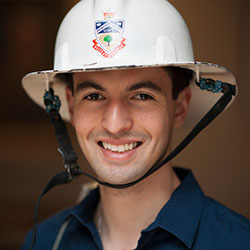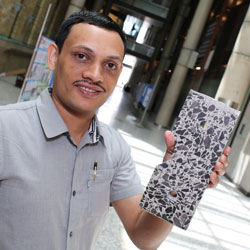This is an excerpt from a longer story, originally posted on Engineering News.
For these U of T Engineering students, the short walk across the stage at Convocation Hall marks both the end of one journey and the beginning of another. This year’s “Grads to Watch” are just a few of the talented Engineering graduates who will receive their degrees at Spring Convocation on June 8. Selected by their home departments, each of these remarkable future Skule™ alumni has made their own unique contribution to enhancing the vibrant community in U of T Engineering—watch their next steps.
Ernesto Diaz Lozano Patiño (CivE 1T5 + PEY)
Leaving a legacy of inspiration
 Diaz Lozano Patiño grew up in Mexico City, in a family where his father, uncle, great-uncle and great-grandfather were all engineers. He sums up his U of T experience in one word: inspiring. “It is incredible to see young, motivated people working hard to solve some of the most complex problems of our world,” he says. “We have people working on cutting edge treatment for cancer, innovative transportation systems, renewable energy sources and much more.”
Diaz Lozano Patiño grew up in Mexico City, in a family where his father, uncle, great-uncle and great-grandfather were all engineers. He sums up his U of T experience in one word: inspiring. “It is incredible to see young, motivated people working hard to solve some of the most complex problems of our world,” he says. “We have people working on cutting edge treatment for cancer, innovative transportation systems, renewable energy sources and much more.”
During his undergrad, he joined the Engineering Society as a representative from Civil Engineering, and pioneered the use of focus groups to foster effective communication between students and the Faculty. He served as president of the Engineering Society for 2015-2016. He was also a founding member of the first chapter of the Canadian Electrical Contractors Association. Following graduation, Diaz Lozano Patiño will begin his MASc with Professor Jeffrey Siegel (CivE), studying building science and indoor air quality. He also plans to to work with other engineers to further develop leadership in the profession, so that “engineers can be more active in shaping the future of our world.”
Shout out: “I’d like to thank all my professors for having been inspiring role models, who have challenged me to think critically and made me reflect deeply on the importance of the Engineering profession.”
Gege Wen (MinE 1T5 + PEY)
Deep thinker
 Wen completed her PEY internship at Husky Energy, where she first heard of deep well injection to dispose of wastewater. She soon learned that deep well injection has also been proposed as a means to store CO2 underground, reducing the impact of greenhouse gas emissions. However, there is still much that is not known about the long-term stability of the method.
Wen completed her PEY internship at Husky Energy, where she first heard of deep well injection to dispose of wastewater. She soon learned that deep well injection has also been proposed as a means to store CO2 underground, reducing the impact of greenhouse gas emissions. However, there is still much that is not known about the long-term stability of the method.
When she returned to U of T, Wen worked with ProfessorJennifer Drake (CivE) to undertake a detailed analysis of the risks and opportunities for deep well injection and CO2 sequestration. Wen plans to continue this research next fall, when she begins her MASc at Stanford University, working with Professor Peter Kitanidis on an inter-disciplinary project that combines CO2 sequestration with enhanced oil recovery.
Shout out: “I want to thank Professor Jennifer Drake. She is a great mentor and her guidance through my research was immensely helpful to my future as a researcher.
Bishnu Gautam (CivE PhD 1T6)
The concrete doctor
 Gautam studied with Professor Daman Panesar (CivE), where he looked for new ways to prevent damage to concrete structures. In particular, he focused on a process known as an alkali-silica reaction. “It is a chemical reaction that causes expansion and cracking in the concrete,” says Gautam. “Once it occurs, complete cure is almost impossible.”
Gautam studied with Professor Daman Panesar (CivE), where he looked for new ways to prevent damage to concrete structures. In particular, he focused on a process known as an alkali-silica reaction. “It is a chemical reaction that causes expansion and cracking in the concrete,” says Gautam. “Once it occurs, complete cure is almost impossible.”
Gautam built a system that could simulate the three-dimensional stresses on various concrete structures and investigated the damage caused by the alkali-silica reaction under these stresses. His research could help civil engineers understand the damage caused by alkali-silica reaction in the context of real structures, and take the appropriate actions before it’s too late.
Gautam, who came to U of T from Nepal, wants to use his degree to bridge the knowledge and technological gap between developed and developing nations. “I hope to promote precast and pre-stressed concrete in developing countries like mine, where such technologies are in their infancy,” he says.
Shout out: “I would like to thank Prof. Panesar for her support, encouragement and most importantly the confidence she put on me. I appreciate the support of my supervisory committee and exam committee members and I am very grateful for the opportunity to work with them.”